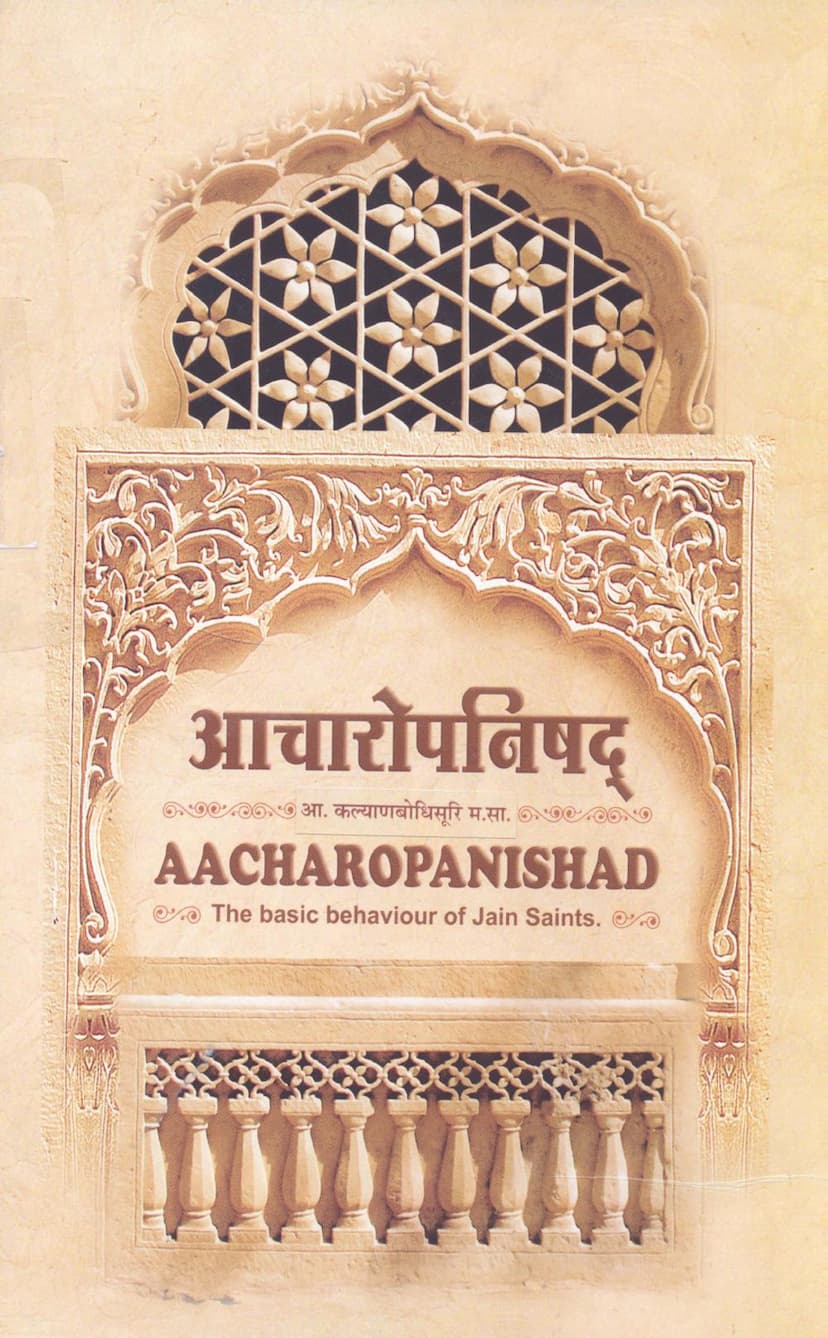Aacharopnishad
Added to library: September 1, 2025

Summary
Here's a comprehensive summary of the Jain text "Aacharopnishad" by Acharya Kalyanbodhisuri, based on the provided pages:
Title: Aacharopnishad (आचारोपनिषद) Author: Acharya Vijay Kalyanbodhisuri (आचार्य विजय कल्याणबोधिसूरीश्वर) Publisher: Shree Jinshasan Aradhana Trust Catalog Link: https://jainqq.org/explore/022077/1
Overview:
"Aacharopnishad" is a Sanskrit text composed of 100 verses (shlokas) that elaborates on the "Dashvidh Samachari" (Ten Types of Conduct or Etiquette) essential for Jain monks (shramans). Authored by Acharya Vijay Kalyanbodhisuri, a disciple of the renowned Acharya Vijay Hemchandrasurishvarji, the book aims to make these fundamental principles of conduct easily accessible and understandable to all monks. The text includes a simple Gujarati translation alongside the Sanskrit verses.
Core Purpose and Philosophy:
The central theme of "Aacharopnishad" is the paramount importance of "Achar" (Conduct). The author emphasizes that true spirituality (adhyatma) and detachment (vairagya) cannot survive without a strong foundation in righteous conduct. Without proper conduct, spiritual discourse can degenerate into mere pretense. Therefore, the primary goal is to help monks establish themselves firmly in their conduct.
The Ten Types of Samachari (Dashvidh Samachari):
The text systematically explains each of the ten types of Samachari, which are traditionally recited by monks during the fortnightly confession (pratikraman) when they acknowledge any lapses in their conduct:
- Ichhakara (इच्छाकार): This refers to seeking permission or expressing willingness before performing an action, often by saying "Itchha karu chhu" (I do it with your permission/will). It signifies respect for the spiritual hierarchy and a humble approach to actions. It leads to good karma and prevents mental distress for others.
- Mithyakara (मिथ्याकार): This is the act of confessing wrongdoing, commonly known as "Michhami Dukkadam" (May my wrongdoing be forgiven). The text emphasizes that true Michhami Dukkadam involves sincere repentance, a commitment to not repeat the offense, and understanding the underlying meaning of the phrase, which involves humility and seeking forgiveness.
- Tathakara (तथाकार): This means agreeing with and obeying the instructions of a guru or elder with unquestioning faith, often by saying "Tathasti" (It is so/I shall do it). It highlights the importance of guru-shishya (teacher-disciple) relationship and the guru's wisdom in guiding the disciple's actions.
- Avashyaki (आवश्यक): This relates to performing essential duties or actions as prescribed by scriptures and the guru, especially when venturing out for necessities like alms. It stresses the importance of purposeful and well-considered actions, with the ultimate aim of supporting the path to liberation.
- Naishedhiki (नैषेधिकी): This involves refraining from or prohibiting certain actions or transgressions. It signifies self-control and adherence to ethical guidelines, often invoked with a phrase like "Nisidhi" (I prohibit). It's about being mindful and preventing wrongdoings.
- Aaprachchha (आपृच्छा): This is the act of seeking guidance or permission from the guru before undertaking any task, especially those related to self-welfare or important decisions. It underscores the principle that all actions should be undertaken with the guru's knowledge and approval for the well-being of the disciple.
- Pratiprchchha (प्रतिपृच्छा): This refers to asking follow-up questions or clarifying instructions from the guru, especially if circumstances change or if there's uncertainty about the original instruction. It ensures continued adherence to the guru's guidance and prevents potential misunderstandings or errors.
- Chhandana (छन्दना): This involves the proper distribution or offering of alms or necessities received, according to the guru's guidance. It's about judicious sharing and ensuring that these resources are used as intended, particularly for those who are self-restrained or performing austerities.
- Nimantrana (निमन्त्रणा): This is the act of inviting or offering service to others, particularly fellow monks or elders, often for alms or assistance, especially when one is tired from spiritual practices. It promotes mutual support and service within the monastic community.
- Upasampada (उपसम्पद्): This refers to acquiring further knowledge or spiritual training from a guru or elder from a different lineage or school. It emphasizes continuous learning and seeking deeper spiritual understanding from various sources when necessary, often for a specific period.
Key Benefits of Practicing Samachari:
The book highlights numerous benefits of adhering to these ten types of Samachari, including:
- Spiritual Growth: Fosters righteous conduct, leads to liberation, and contributes to the acquisition of true spiritual knowledge and character (Yathakhyat Charitra).
- Karma Purification: Helps in the shedding of karmic matter and accumulation of merit.
- Harmony and Respect: Promotes mutual love and respect among monks, strengthens the guru-shishya bond, and prevents discord within the community.
- Discipline and Righteousness: Ensures that actions are aligned with Jain principles and scriptures, leading to a meaningful monastic life.
- Inner Peace: Cultivates humility, repentance, and a sense of responsibility.
Structure and Style:
The "Aacharopnishad" is presented in a clear and accessible manner. It begins with invocations and then systematically explains each Samachari with Sanskrit verses followed by a Gujarati translation. The author has strived to create a text that is easily memorized and understood, even by those with less exposure to complex philosophical texts. The verses are poetic and aim to be melodious, facilitating memorization.
Context and Significance:
The book was created in response to a need identified during a congregation of monks, where it was recognized that many lacked a clear understanding of the ten types of Samachari. The text serves as a practical guide to ensure that these fundamental aspects of monastic discipline are preserved and followed correctly, thereby upholding the integrity of the Jain monastic tradition and guiding aspiring monks towards spiritual excellence. The author expresses his devotion to his gurus and the Jain lineage throughout the text.